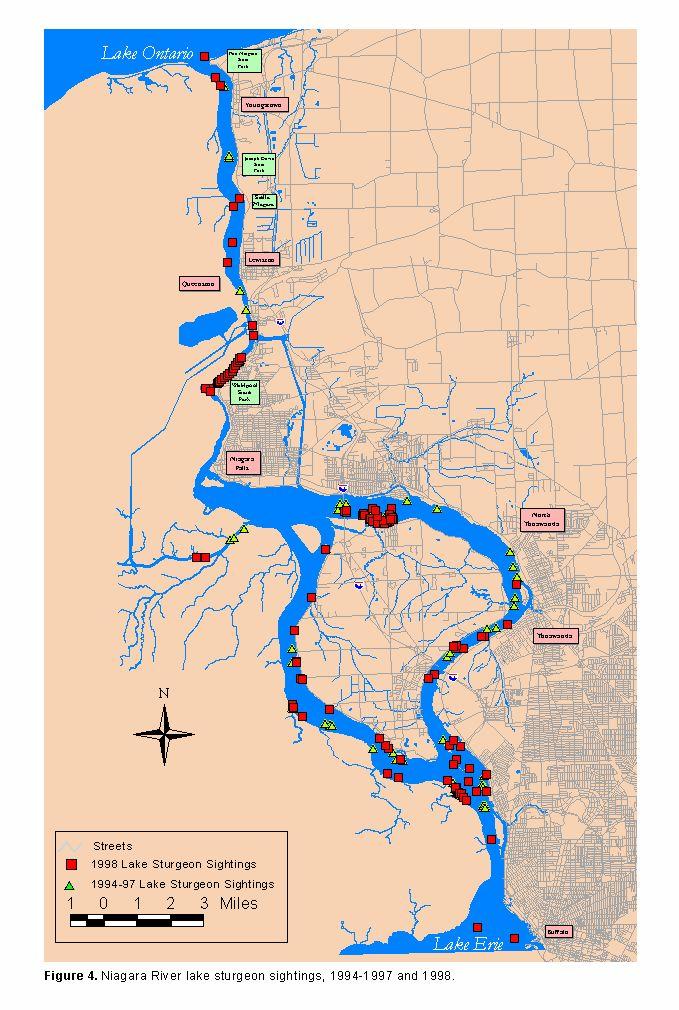1998 Public Participation Summary Report
Anecdotal information of lake sturgeon has been reported by
recreationalists and commercial fishermen since 1994. This
initiative
has been implemented in all lower Great Lakes waters and continues to
be
a substantial contribution to population assessment in the Great
Lakes.
We summarized data from all sightings in the upper Niagara River from
1994-97,
which included 40 reports of 117 fish.

Sightings from 1994-97 indicate successful natural reproduction and
year class structure within the population as suggested by annual
juvenile
sightings, <24 inches. Also, the west river (mostly Canadian
waters)
has significantly larger lake sturgeon (avg. 54 inches) reported than
the
east river (U.S. waters; avg. 21 inches). This suggests possible
habitat differences between the west and east rivers; however, data
provided
by participants indicate little difference. Average depth of
sightings
in the west and east rivers were 19 feet and 21 feet, respectively and
substrate descriptions were similar. Many sightings were reported
in June and July, likely biased by increased diving activity. The
Frenchman’s Creek area received weekly dive trips throughout the diving
seasons; however, a larger number of lake sturgeon were sighted during
August, suggesting a high use area during this time.



Public education was significantly increased in 1998.
First,
an appreciation dinner was held at the LGLFRO for divers participating
in the sighting program. As suggested at the dinner, a poster of
the upper Niagara River was developed with current sightings and lake
sturgeon
educational items. The poster was placed in nine dive shops in
Canada
and the U.S. to increase awareness and sighting reports. A web
page,
entitled ‘Niagara River Lake Sturgeon Project’ was developed and placed
on the Niagara Divers’ Association web site
(www.niagaradivers.com).
Lake Sturgeon Sighting Alert cards, developed by Ohio Division of
Wildlife,
were distributed to approximately 200 marinas, bait shops, and boat
launches.
Also, an ‘Alert’ notice was placed in the NYSDEC 1998-99 Fishing
Regulations
Guide to increase angler awareness and reports. As a result of
the
increased effort, 86 lake sturgeon reports with 120 sightings, were
filed
by our office in 1998. Previously, the most reports ever
submitted
in one year to the LGLFRO was 12.
In 1998, 81 sightings from 59 reports (69%) were from the
upper
Niagara River. Compared to reports from 1994-1997, the 1998 upper
river sightings showed increased diversity in the lengths of lake
sturgeon
in both the east and west rivers. Most sightings were reported in
June and July, again likely due to increased diving activity. A
significant
finding from 1998 sightings was an abundance of YOY lake sturgeon at
the
northern tip of Grand Island, in the east river. Sixteen of
twenty-four
(66%) were sighted on 15 August. The lengths of most sightings
were
between 3 and 8 inches. This location is called the Grasse Island
area due to a large island of emergent vegetation. The water
currents
appear to be reduced in this area. Divers reported substrates
primarily
of sand and gravel with some reporting cobble. Total depths
averaged
15.5 feet, with a range of 12 to 18 feet. Vegetative abundance
was
reported sparse to moderate. The LGLFRO set gillnets and trawled
in the area in mid-October; however only one mudpuppy was caught in the
trawl.
Mass Dive
Also, during the appreciation dinner divers suggested to conduct
what was named a “mass dive.” On 13 June, 1998, eight boats and a
total of 26 divers from both Canada and the U.S. conducted the “mass
dive”
to better identify lake sturgeon distribution and abundance in the
upper
Niagara River. Two dives, spread across the width of the West
Niagara
River (Canadian side), covered approximately 6 km of river. Two
juvenile
lake sturgeon (approx. 12” and 24”) were sighted by divers. These
sightings were important because, prior to the “mass dive,” only one
juvenile
had been reported (from 1994-1997) in the West River. Juveniles
in
the West River could be an indicator of successful reproduction
occurring
within this river branch.

The “mass dive” provided an excellent educational opportunity
for the diving community to interact with LGLFRO biologists and learn
more
about the lake sturgeon. It also allowed LGLFRO biologists to
further
explore the potential for diver sightings to be used as a method of
lake
sturgeon population assessment.



Background
-
A short, but very educational background of Lake Sturgeon in the Great
Lakes.
Niagara
River Project - Draft scope for the Niagara River Sampling for 1998.
Return to NDA
Homepage







